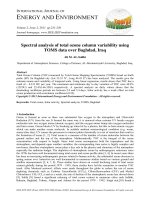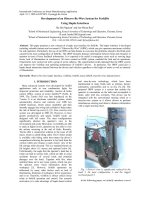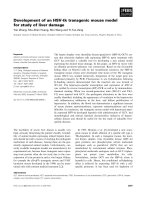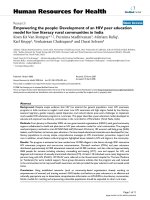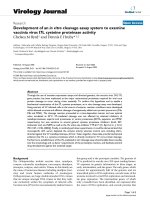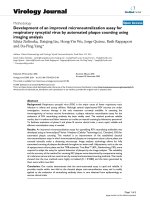- Trang chủ >>
- Khoa Học Tự Nhiên >>
- Vật lý
development of an ozone gas sensor using single - walled carbon nanotubes
Bạn đang xem bản rút gọn của tài liệu. Xem và tải ngay bản đầy đủ của tài liệu tại đây (652.7 KB, 5 trang )
Sensors and Actuators B 140 (2009) 407–411
Contents lists available at ScienceDirect
Sensors and Actuators B: Chemical
journal homepage: www.elsevier.com/locate/snb
Development of an ozone gas sensor using single-walled carbon nanotubes
Youngmin Park
a
, Ki-Young Dong
a
, Jinwoo Lee
a
, Jinnil Choi
a
, Gwi-Nam Bae
b
, Byeong-Kwon Ju
a,∗
a
Display and Nanosystem Laboratory, College of Engineering, Korea University, Seoul, Republic of Korea
b
Center for Environmental Technology Research, Korea Institute of Science and Technology, Republic of Korea
article info
Article history:
Received 25 September 2008
Received in revised form 31 March 2009
Accepted 30 April 2009
Available online 7 May 2009
Keywords:
Single-walled carbon nanotubes
Gas sensor
O
3
gas
N,N-dimethylformamide (DMF)
Thermal treatment
abstract
This study deals with the fabrication of an ozone gas sensor using single-walled carbon nanotubes (SWC-
NTs) as sensing material. The SWCNTs are dispersed by N,N-dimethylformamide (DMF). The CNT-DMF
solution was dropped between interdigitated electrodes’ fingers to fabricate ozone gas sensor. For ozone
environment, a commercial ozone generator was introduced. To improve sensor response, the deposited
carbon nanotubes network was thermally treated at high temperature in a furnace. The sensor exhibits
high sensitivity to ozone gas at concentration as low as 50 ppb, and fast response time, which is promising
for future commercialization of carbon nanotubes based ozone gas sensor.
© 2009 Elsevier B.V. All rights reserved.
1. Introduction
Seriousness of increasing atmospheric pollution resulting from
industrialization has led to significant interest in sensing toxic
gases. Various studies of gas sensors for detection of different kinds
of hazardous gases have been conducted. Research has also been
focused on sensing materials whose properties allow fast response
and high sensitivity to certain gases. Since it was reported that
the electrical properties of carbon nanotubes (CNTs) change by
adsorption of gases, CNT-based gas sensors have been studied [1].
However, although many results of noxious gases detection includ-
ing NO
x
[2],CO[3],NH
3
[4], volatile organic compounds (VOC) [5]
were reported, there have been few research results involving ozone
gas detection by CNT sensors. Ozone at the ground level, indirectly
discharged from auto exhaust, is one of the harmful pollutants and
the greenhouse gases. It is also the main cause of photochemical
smog and atmosphere contamination. According to the air quality
standard established by the U.S. environmental protectionagency in
2008, ozone is required to have a concentration lower than 75 ppb.
A UV adsorption method is the standard method for ozone detec-
tion [6]. Although this method is reliable and has a high sensitivity,
it has drawbacks in the complexity of the apparatus with high
cost and large detector size. On the other hand, the ozone sensors
based on metal oxide thin film, which utilizes an electrochem-
∗
Corresponding author at: School of Electrical Engineering, College of Engineer-
ing, Korea University, 5-1, Anam-Dong, Seongbuk-Gu, Seoul 136-713, Republic of
Korea. Tel.: +82 2 3290 3237; fax: +82 2 3290 3791.
E-mail address: (B K. Ju).
ical detection method, have also been developed with ZnO [7],
WO
3
[8], InO
3
[9], etc. used as sensing materials. They have advan-
tages such as compact size and high sensitivity; however, there is
a severe limitation due to their high operational temperature [10].
In order to overcome these disadvantages, studies of ozone detec-
tion with SWCNT-based gas sensors have been conducted. In an
existing research study of ozone detection, SWCNT film, grown by
chemical vapor deposition (CVD), was used to detect ozone gas,
but showed a limitation due to a long response time of 200 min
[11,12].
In the present study, we developed a SWCNT-based gas sen-
sor for ozone detection with a concentration down to 50 ppb at
room temperature. Commercial SWCNTs were dispersed in N,N-
dimethylformamide (DMF) and deposited over electrodes with
conventional interdigitated design. To enhance the performance,
a heating component was integrated into the gas sensor.
2. Experiment
Our sensor consists of an interdigitated Pt electrode on the top
and a Pt microheater at the bottom. The electrodes are 20 min
width with gap size of 20 m and 200 nm in thickness. Electrical
insulating layers are stacked between the electrodes and the
microheater. The layers consist of oxide–nitride–oxide (O–N–O)
structure. The silicon substrate was etched away by using an
anisotropic etchant (KOH) to achieve the thermal isolation of the
substrate. SWCNTs (purchased from Iljin Nanotech Co. Ltd.) have
properties of 1–1.2 nm in average diameter, 5–10 m in length
and ∼90% in purity (prepared by an arc-discharge process). No
further purification was performed on the as-received SWCNTs. A
0925-4005/$ – see front matter © 2009 Elsevier B.V. All rights reserved.
doi:10.1016/j.snb.2009.04.055
408 Y. Park et al. / Sensors and Actuators B 140 (2009) 407–411
Fig. 1. Schematic diagram of CNT-based sensor fabrication. CNT solution was dropped and evaporated in room temperature.
stable suspension of SWCNTs in DMF was prepared by sonicating
the SWCNTs in DMF at a concentration of 0.02 wt% for 4 h (at a
pulse cycle: 2 s on, 2s off, and at 200 W). Then, the SWCNT-DMF
solution was dropped using a syringe between the interdigitated
Pt electrodes fabricated by MEMS process. It was experimentally
found that the resistance of the SWCNTs network ranged from
several k to several tens of k, depending on the density of the
SWCNTs across the interdigitated electrodes. In these experiments,
the resistance was measured af ter the organic solvent DMF was
removed by evaporation. Two types of the sensor samples were
fabricated. Sample 1 was dried at room temperature after dropping
the SWCNT-DMF solution. For sample 2, additional heating in
furnace at 350
◦
C for 30 min was performed. The whole processing
steps of our sensor fabrication are shown in Fig. 1, briefly.
A test gas of ozone was produced by a commercial ozone gen-
erator. Fig. 2 shows our measurement system. When the ozone
gas generated from the ozone generator was introduced into
the measurement chamber, the changes in resistance of SWCNTs
were automatically monitored by LABVIEW software and KEITHLEY
Fig. 2. Schematic diagram of experimental setup.
2400. The effect of thermal treatment was investigated by compar-
ing the responses of sample 1 and sample 2 at 1 ppm ozone gas. We
also measured the changes in resistance of the CNT sensor when
it was exposed to ozone gases with five different concentrations
of 50, 100, 200, 500 ppb, and 1 ppm, sequentially. A dry air was
used as carrier gas in order to obtain different concentration. The
ozone generator that we used produced ozone by projecting UV
to dry air. The concentration of the ozone could be controlled by
the ozone generator up to 1 ppm. Every experimental process was
performed at room temperature except for the recovery stages. The
microheater and a rotary pump were utilized only for the recovery
processes, providing self heating. The ozone gas was injected into
the measurement chamber at a flow rate of 4 L/min. In addition, a
dry filter was set up between the measurement chamber and the
ozone generator in order to remove the influence of environmental
humidity during the experiment.
3. Results and discussion
Fig. 3 shows the fabricated sensor, where Fig. 3(a)–(c) are the
images of packaged sensor chip, heater and electrode, diaphragm,
respectively. Fig. 3(d) is the SEM image of the dispersed SWC-
NTs by DMF. The DMF organic solvent was chosen as a dispersing
agent for SWCNTs because the amide groups of DMF can be eas-
ily adsorbed to the nanotubes wall to debundle the SWCNTs and
provide a uniformly suspended SWCNT solution [13,14]. We exper-
imentally found that the resistance value of the SWCNTs network
was increased from 3.4 to 4.8 k after thermal treatment. This phe-
nomenon will be discussed later.
Fig. 4 shows the result of ozone detection using sample 1. In our
experiment, the sensor response, S, was defined by S = R/R
o
× 10 0,
where R = R
t
− R
o
. R
t
and R
o
were the resistance values of the sen-
sor with andwithout ozone gas exposure, respectively. When 1 ppm
ozone gas was introduced to the measurement chamber, the sensor
response was changed by 9.8% for 50 0 s. After that, a 2% recovery
was obtained by degassing thechamber for 500 s. During the second
cycle, with the same concentration of ozone and the same period of
gas injection and degassing, the change of the sensor response was
11%. This change was a little bit more than that of the first cycle. At
Y. Park et al. / Sensors and Actuators B 140 (2009) 407–411 409
Fig. 3. Sensor and dispersed SWCNTs images: (a) fabricated sensor chip and (b) electrode and heater image. (c) SEM image of diaphragm cross-section and (d) SEMimageof
the dispersed SWCNTs.
the second recovery stage, the sensor response decreased back to
9.8%.
As reported in the literature [11,15], the mechanism of the resis-
tance change of SWCNTs exposed to ozone gas is as follows: an O
3
molecule has one unpaired electron and is a strong oxidizer. Upon
O
3
adsorption, electron transfer is likely to occur from the CNTs
being exposed to O
3
because of the electron-withdrawing power
of the O
3
molecules. The O
3
adsorption depletes electrons from
the CNTs resulting in an increase of the concentration of conduct-
ing holes, which are the majority carrier in the CNT networks. This
leads to the decrease in resistance observed in the experiment [11].
However, as shown in Fig. 4, there is a limit in recovery only by
degassing the chamber. This is probably because the chemisorp-
tion binding between O
3
molecules and SWCNTs are too strong to
break by degassing [16] and because the oxidation due to ozone
may form carbonyl or alcohol group on the nanotube surface [17].
Our gas detection system is a static type so that the pressure
inside the gas chamber changes during an experiment. The tem-
perature of our sensor can also vary during recovery because of the
Fig. 4. Response of the SWCNT-based sensor to O
3
of 1 ppm without thermal treat-
ment.
heating operation by a microheater. In addition, there is a possibil-
ity for oxygen in ozone environment to have an effect on our sensor
response. The effects of these factors were explored through several
experiments on ozone sensing results. The sensor resistance varied
little as the pressure and the temperature in gas chamber changed
by injecting and evacuating O
2
gas and turning on a microheater
(Fig. 5), respectively. Furthermore, though the sensor resistance
showed fluctuating tendency when exposed to oxygen, a resistance
variation of the sensor was much less than that when exposed to
ozone (Fig. 5). These findings confirm the validity of our sensor
response to ozone.
Fig. 6 shows the responses of sample 1 and sample 2 at 1 ppm of
ozone gas. The improved responses of the sensor under ozone gas
exposure after the thermal treatment, compared to those before
thermal treatment, were calculated and are itemized in Table 1.
In the case of sample 1, the sensor response was 9.8% for 500 s.
In comparison, sample 2 was saturated within almost a 100 s after
exposure to ozone gas. It was recognized that the sensor response
was 14.7% which was an increased value compared to the sample
Fig. 5. Sensor response to oxygen: (1) and (3), oxygen injection to gas chamber; (2)
and (4), turning on a microheater and outgassing the gas chamber by using rotary
pump.
410 Y. Park et al. / Sensors and Actuators B 140 (2009) 407–411
Fig. 6. Comparison of the sensor response before and after thermal treatment. The
thermal treatment was performed in furnace at 350
◦
C for 30 min.
without the thermal treatment. Although the data given at Table 1
are the experimental values of two samples, and thus could raise
reproducibility issue, we obtained just slightly different experi-
mental results for each sensor sample and unchanged tendency.
It confirmed that the sample with thermal treatment showed more
improved sensor response (relative resistance change and response
time) than that without the treatment. In accordance with the gas
detection principle, where the concentration change of majority
carrier in p-type semiconducting SWCNT is derived and the elec-
trical conductance is changed on ozone gas exposure, results from
Fig. 6 will be explained further below. As reported previously, the
structural rearrangement within the SWCNT bundles occurs and
the electrical properties of the SWCNTs change from semiconduct-
ing behavior to metallic response as the temperature is increased
[18]. It was also reported that the electrical properties of the SWC-
NTs changed from metallic back to semiconducting behavior, when
the temperature exceeded 300
◦
C and coole d back to room temper-
ature [19]. It seems that the ratio of the p-type semiconducting
SWCNT increased in the CNT network which had both metallic
SWCNT and p-type semiconducting SWCNT on the basis of the
fact that the resistance of the SWCNTs is increased and its elec-
trical properties are returned to the semiconducting behavior. The
increase in sensor response to ozone gas supports that the CNT net-
work became a more responsive sensing material of the gas after
the thermal treatment.
Fig. 7 shows the response of sample 2 being continuously
exposed to the ozone gas with various concentrations. Our sen-
sor showed high sensor response for ozone gas even at 50 ppb. The
sensor was saturated nearly 200 s after being exposed to 50 ppb
of ozone gas. After saturation, we stopped the ozone gas injection.
Recovery was conducted by turning on a heater and degassing the
ozone gas in the chamber with a rotary pump. The responses for
the various concentrations were easy to distinguish. As the con-
centration of the ozone gas introduced to the chamber increased,
the variation of the sensor resistance also increased. When 50, 100,
200, and 500 ppb of ozone gases were injected, it was observed
that the sensor response was changed by 11.1, 12.3, 13.3, and 14.1%,
respectively. When the sensor was reacted to 1 ppm of ozone after
500 ppb of that, the sensor resistance variations was almost same to
each other. Consequently, it seemed that the sensor was saturated.
Table 1
Comparison of the gas sensor performance before and after thermal treatment on
1 ppm ozone gas.
Before thermal
treatment
(sample 1)
After thermal
treatment
(sample 2)
Relative resistance changes (%) 9.8 14.7
Response time (s) 500 100
Fig. 7. Response of the SWCNT-based sensor at various O
3
concentration. The con-
centrations of O
3
gas were 50, 100, 200, 500 ppb, and 1 ppm, sequentially. The
microheater and the rotary pump were used for recovery.
4. Conclusion
We demonstrated ozone detection using SWCNT networks. The
SWCNT networks utilized as a sensing material were deposited
across the interdigitated electrode’s fingers after being dispersed
with DMF in a solution form. The SWCNT networks were sensitive
to ozone down to 50 ppb. Upon exposure to ozone gas, the resis-
tance of the SWCNT-based sensor decreased with an increase in
concentration of the ozone gas, which states that the SWCNTs have
p-type semiconducting property at room temperature. Our sensor
showed a rapid response as well as a fast recovery. The SWCNT net-
works with thermal treatment exhibited an improvement in sensor
response. This result clearly shows that an SWCNT-based gas sensor
can be a good candidate for sensitive ozone detection, surpassing
existing methods due to its high sensitivity, simplicity in fabrication
and compact size.
Acknowledgements
This work was supported by the IT R&D program of MKE/IITA
[2006-S-078-03, Environmental Sensing and Alerting System with
Nano-wire and Nano-tube] and partially supported by the National
Research Laboratory NRL (R0A-2007-000-20111-0) Program of the
Ministry of Science and Technology in Korea Science. We thank the
government for financial support.
References
[1] B. Mahar, C. Laslau, R. Yip, Y. Sun, Development of carbon nanotube-based
sensors—a review, IEEE Sens. J. 7 (2) (2007) 266–284.
[2] W.S. Cho, S.I. Moon, Y.D. Lee, Y.H. Lee, J.H. Park, B.K. Ju, Multiwall carbon nan-
otube gas sensor fabricated using thermomechanical structure, IEEE Electron
Device Lett. 26 (7) (2005) 498–500.
[3] S. Santucci, S. Picozzi, F. Di Gregorio, L. Lozzi, C. Cantalini, L. Valentini, J.M. Kenny,
B. Delley, NO
2
and CO gas adsorption on carbon nanotubes: experiment and
theory, J. Chem. Phys. 119 (20) (2003) 10904–10910.
[4] M.D. Ellison, M.J. Crotty, D.H. Koh, R.L. Spary, K.E. Tate, Adsorption of NH
3
and
NO
2
on single-walled carbon nanotubes, J. Phys.Chem.B108(2004) 7938–7943.
[5] M. Penza, F. Antolini, M. Vittori Antisari, Carbon nanotubes as SAW chemical
sensors materials, Sens. Actuators B: Chem. 100 (2004) 47–59.
[6] J.P. Lodge, Methods of air sampling and analysis, in: Intersociety Committee,
3rd ed., Lewis Publishers, Chelsea, MI, 1989, pp. 836–839.
[7] R. Martines, E. Fortunato, P. Nunes, I. Ferreira, A. Marques, M. Bender, N. Kat-
sarakis, V. Cimalla, G. Kiriakidis, Zinc oxide as an ozone sensor, J. Appl. Phys. 96
(3) (2004) 1398–1408.
[8] K. Aguir, C. Lemire, D.B.B. Lollman, Electrical properties of reactively sputtered
WO3 thin films as ozone gas sensor, Sens. Actuators B: Chem. 84 (2002) 1–5.
[9] S.R. Kim, H.K. Hong, C.H. Kwon, D.H. Yun, K.C. Lee, Y.K. Sung, Ozone sensing
properties of In
2
O
3
-based semiconductor thick films, Sens. Actuators B: Chem.
66 (2000) 59–62.
[10] T.K.H. Starke, G.S.V. Coles, High sensitivity ozone sensors for environmental
monitoring produced using laser ablated nanocrystalline metal oxides, IEEE
Sens. J. 2 (1) (2002) 14–19.
[11] S. Picozzi, S. Santucci, L. Lozzi, C. Cantalini, C. Baratto, G. Sberveglieri, I. Armen-
tano, J.M. Kenny, L. Valentini, B. Delley, Ozone adsorption on carbon nanotubes:
Y. Park et al. / Sensors and Actuators B 140 (2009) 407–411 41 1
ab initio calculations and experiments, J. Vac. Sci. Technol. A22 (4) (2004)
1466–1470.
[12] J.M. Simmons, B.M. Nichols, S.E. Baker, M.S. Marcus, O.M. Castellini, C.S. Lee,
R.J. Hamers, M.A. Eriksson, Effect of ozone oxidation on single-walled carbon
nanotubes, J. Phys. Chem. B 110 (2006) 7113–7118.
[13] J. Li, Y. Lu, Q. Ye, M. Cinke, J. Han, M. Meyyappan, Carbon nanotube sensors for
gas and organic vapor detection, Nano Lett. 3 (2003) 929–933.
[14] C.A. Furtado, U.J. Kim, H.R. Gutierrez, L. Pan, E.C. Dickey, P.C. Eklund, Debundling
and dissolution of single-walled carbon nanotubes in amide solvents, J. Am.
Chem. Soc. 126 (2004) 6095–6105.
[15] N. Sano, F. Ohtsuki, Carbon nanohornsensorto detect ozone inwater,J.Electrost.
65 (2007) 263–268.
[16] W.L. Yim, J.F. Liu, A reexamination of the chemisorption and desorption of ozone
on the exterior of a (5,5) single-walled carbon nanotube, Chem. Phys. Lett. 398
(2004) 297–303.
[17] N.I. Kovtyukhova, T.E. Mallouk, L. Pan, E.C. Dickey, Individual single-walled nan-
otubes and hydrogels made by oxidative exfoliation of carbon nanotube ropes,
J. Am. Chem. Soc. 125 (2003) 9761–9769.
[18] N.H. Quang, M.V. Trinh, B.H. Lee, J.S. Huh, Effect of NH
3
gas on the electrical
properties of single-walled carbon nanotube bundles, Sens. Actuators B: Chem.
113 (1) (200 6) 341–346.
[19] L. Valentini, I. Armentano, J.M. Kenny, C. Cantalini, L. Lozzi, S. Santucci, Sensors
for sub-ppm NO
2
gas detection based on carbon nanotubes thin films, Appl.
Phys. Lett. 82 (6) (2003) 961–963.
Biographies
Youngmin Park received his B.S. in School of Electrical Engineering from Korea
University in 2007. From 2007, he is currently working toward his M.S. degree. His
research interests are carbon nanotubes based gas sensor and nanoimprint lithog-
raphy.
Ki-Young Dong received his B.S. in School of Electrical Engineering from MyongJi
University in 2007. From 2007, he is a master course in the program in micro/nano
system, Korea University. His research interests are carbon nanotubes based gas
sensor and nanoimprint lithography.
Jinwoo Lee received his Ph.D. degree from the Department of Materials Sci-
ence, Seoul National University in 1999. He worked in Max-Planck Institute for
micro-structural physics, Germany and in Watter-Schottkey Institute of Technische
Universitat Munchen, Germany. He joined Korea University as a research professor
from 2006 for the development of nanoscale sensor and Bio MEMS.
Jinnil Choi received his Ph.D. degree in 2008 from the Department of Mechanical
Engineering, Swansea University, United Kingdom. Since then, he joined Korea Uni-
versity as a research professor. His recent interests include patterning of nanoscale
structures and nanoscale powder compaction.
Gwi-Nam Bae received the M.S. degree in 1987 and Ph.D. degree in 1994 from
the Department of Aerospace Engineering, Korea Advanced Institute of Science and
Technology (KAIST), Daejeon, Korea. He is currently a principal research scientist at
the Center for Environmental Technology Research, Korea Institute of Science and
Technology (KIST), Seoul, Korea. He has studied on microcontamination control in
a cleanroom environment, aerosol monitoring in background and urban sites, and
indoor air pollution since 1987. His current research interests cover vehicle-related
ultrafine particles, aerosol instrumentation, indoor air quality, and air cleaning
devices. Dr. Bae is a member of the American Association for Aerosol Research
(AAAR), the Korean Society for Indoor Environment (KOSIE), and the Korean Society
for Atmospheric Environment (KOSAE). He has authored or co-authored over 100
papers.
Byeong-Kwon Ju received the M.S. degree from the Department of Electronic
Engineering, University of Seoul, Seoul, Korea, in 1988, and the Ph.D. degree in semi-
conductor engineering from Korea University, Seoul, in 1995. In 1988, he joined the
Korea Institute of Science and Technology (KIST), Seoul, where he was engaged in
the development of mainly silicon micromachining and micro-sensors as a princi-
pal research scientist. In 1996, he spent 6 months as a visiting research fellow with
the Microelectronics Centre, University of South Australia, Australia. Since 2005, he
has been an associate professor with Korea University, where his main interests are
in flexible electronics (OLED and OTFT), field emission device, MEMS (Bio and RF),
and carbon nanotube-based nano systems. Prof. Ju is a member of the Society for
Information Display (SID), the Korea Institute of Electrical Engineering (KIEE), and
the Korea Sensor Society. He has authored or co-authored over 240 journals.
